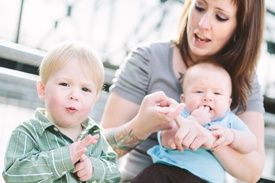 Infant sign language really does deliver on its promise of improved communication. This is particularly appealing for new parents, given that there’s a well-recognized gap between what babies and toddlers want to say and what they are able to say. Sign language can help ease frustration between ages 8 months and 2 years — when children begin to know what they want, need, and feel but don't always have the oral motor verbal skills to express themselves. Basic sign language can help babies better express themselves as early as 8 or 9 months and it can mean decreased frustration (for both caregiver and child), promote earlier language skills and enhanced bonding with those who sign.
Infant sign language really does deliver on its promise of improved communication. This is particularly appealing for new parents, given that there’s a well-recognized gap between what babies and toddlers want to say and what they are able to say. Sign language can help ease frustration between ages 8 months and 2 years — when children begin to know what they want, need, and feel but don't always have the oral motor verbal skills to express themselves. Basic sign language can help babies better express themselves as early as 8 or 9 months and it can mean decreased frustration (for both caregiver and child), promote earlier language skills and enhanced bonding with those who sign.
Research from the National Institutes of Health compared two groups of 11-month-old babies. One group was taught baby sign language and verbal training. The second group was given verbal training only. They concluded that the signing group became more advanced talkers than the group given verbal training only. The signing group exhibited verbal skills three months ahead of the non-signers at two years old. Even at three years old, the signers were still ahead.
Tips for Getting Started
To get the most out of your baby sign language experience, keep these tips in mind:
- Familiarize Yourself. To begin teaching your child baby sign language, familiarize yourself with signs through books, websites videos or other sources. Like the hand wave for “bye-bye”, many signs have a motion – videos can be particularly helpful.
- Use the “true” sign. Take the time to learn the accepted sign based on American Sign Language (ASL) so that others who may sign will understand your baby and your baby will understand them.
- Set realistic expectations. Feel free to start signing with your child at any age — but remember that most children aren't able to begin using baby sign language on their own until about age 8 months. Also, babies often “approximate” a sign – they may not yet have the ability to get the handshape or motion completely correct – that’s OK!
- Keep signs simple. Choose signs that are of most interest to your child. In addition to using formal signs, use natural gestures, such as pointing and the hand movements that accompany nursery rhymes like the “Itsy Bitsy Spider”.
- Make it interactive. Try holding your baby on your lap, with his or her back to your stomach. Try hand-over-hand signing – do the sign yourself then gently hold your baby's arms and hands to make signs.
- Real Time/Here and Now Signing Use the sign paired with the activity. Sign “eat” as you eat, sign “book” as you are holding a book, sign “book” and “all done” as you finish the book, sign “milk” as you show a bottle.
- Keep at it. Don't get discouraged if your child uses signs incorrectly or doesn't start using them right away. The goal is improved communication and reduced frustration — not perfection. Keep in mind that, as you teach baby sign language, it's important to continue talking as you sign
- Sing and Sign. Learn and add signs to your child’s favorite songs like Twinkle Twinkle, You Are My Sunshine, and Old MacDonald.
- Speak and Sign Be sure you don’t cut back on the amount of time you spend talking with your baby. As long as signing does not take the place of speaking, it won’t get in the way of your baby’s learning to talk with her words as well as her hands.
- Close counts! Don’t worry if your baby doesn’t get the signs quite right. If you’re not sure, model the sign as you say the word again. Remember, the goal is to have fun communicating and lessen frustration, not add to it!
- Share your signs. Be sure you share your signs with your baby’s other caregivers so that everyone can join in on (and understand) the conversation once your baby begins to sign.
Favorite Signs
Fingerspelling while singing the A-B-C Song is fine, but the most useful signs for infants and toddlers are signs for words that are part of your child’s daily life and serve a function for what your baby wants, needs or are doing right then. If your baby loves trucks, learn the sign for truck. If your baby loves the Baby Shark song, learn the sign for shark.
The following are early favorites:
- Airplane
- Baby
- Ball
- Bath
- Bird
- Book
- Cat
- Cup
- Cold
- Daddy
- Diaper
- Dog
- All done
- Drink
- Eat
- Go
- Happy
- Help
- Hot
- I love you
- Milk – often used for bottle
- Mommy
- More
- No/yes
- Please
- Sit
- Sleep
- Star
- Thank you
- Up
- Water









